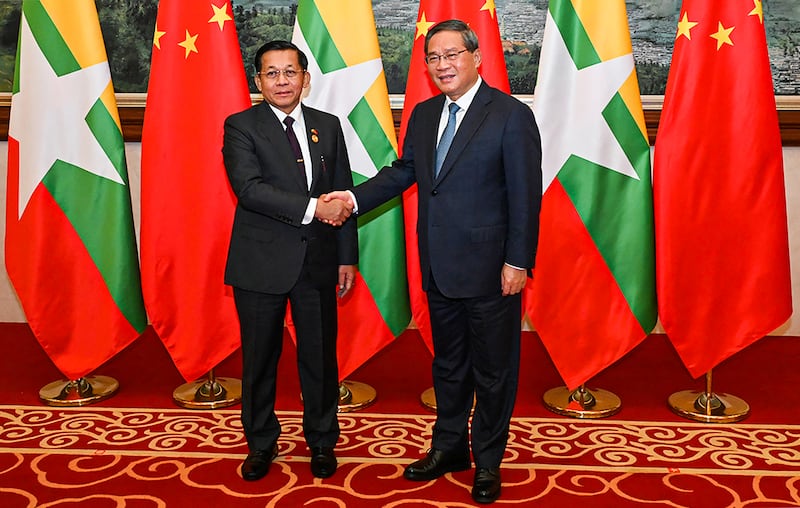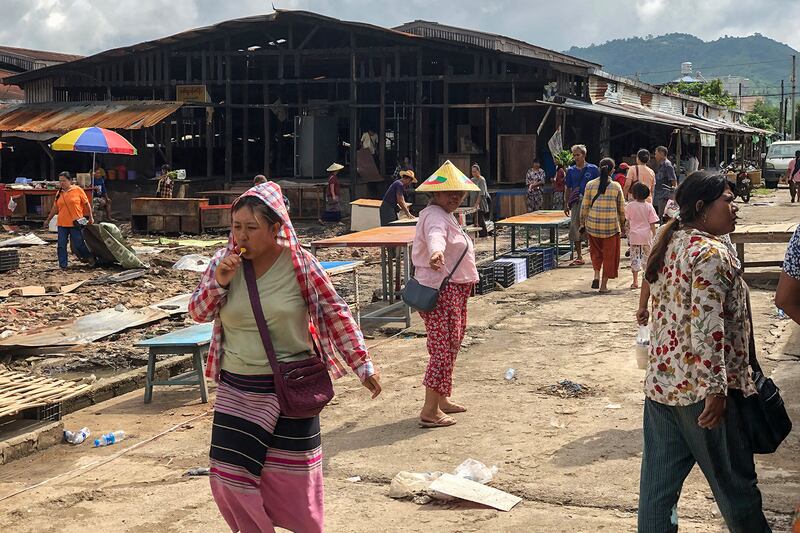The regime faces dug-in opponents on many fronts amid strong anti-China sentiment.
Myanmar’s military dictator, Min Aung Hlaing, returned from a five-day trip to China, his first since the February 2021 coup, with promises of further Chinese assistance, in a desperate attempt to shore up his flailing regime and bankrupt economy.
Min Aung Hlaing was invited to attend the 8th Greater Mekong Subregion Forum, and was kept confined to Kunming, the capital of neighboring Yunnan province.
Though he failed to get the legitimizing meeting with Xi Jinping that he had hoped for, he held talks with Prime Minister Li Qiang.
The junta chief had one overriding priority: securing additional Chinese military assistance.
The junta leader pledged that he was ready to sit down and talk peace with the opposition, but only “if they genuinely want peace” – i.e. stop fighting.
There were other matters on his agenda.

Min Aung Hlaing met with the prime ministers of Thailand, Vietnam, Cambodia and Laos. It was the first time since the coup that the State Administrative Council – as the junta is formally known – enjoyed such diplomatic legitimization.
The junta chief also met with Chinese businessmen and state-owned enterprises, promising an array of tax holidays in return for investments in energy, infrastructure or electric vehicle projects.
So desperate for investment, Min Aung Hlaing promised that all projects could be funded with yuan, rather than U.S. dollars. Despite traveling to China with a large contingent of military-backed businessmen, he returned home with no firm commitments of investment.
China continues to push for a ceasefire and has backed progress towards national elections.
At the same time, Beijing has stepped up support for the military, which may have been the justification for the Oct. 18 grenade attack at their consulate in Mandalay.
Anti-Chinese sentiment has never been higher among the opposition and citizenry.
Border trade, railway construction
Li Qiang had two inter-connected priorities in his meeting with Min Aung Hlaing.
The first was the reopening of border trade, which China had shut to pressure the Kachin Independence Army (KIA) and the Three Brotherhood Alliance, who control almost all border crossings, to stop their offensive.
The second was the start of construction of the rail line and highway from the Chinese border town of Ruili to the Chinese concession in Kyaukphyu, where Chinese firms are constructing a special economic zone and deep-water intermodal port.
In the face of potential tensions with the United States, the Andaman Sea port is a strategic priority for Beijing that fears the U.S. ability to block the Strait of Malacca.
The KIA and the Three Brotherhood Alliance continue to defy China, despite the economic damage to the local population, which is highly dependent on border trade.
As of now only one of five official border posts, Mongla, is open. China has not restored electricity and internet service to many of the border towns as punishment.
Under Chinese pressure, the Myanmar National Defense Alliance Army (MNDAA), had to publicly distance themselves from the National Unity Government (NUG), the shadow opposition government.
And yet they continue to defy Beijing, both continuing their military operations and coordination with the NUG.

Since July, the KIA has captured 12 more towns and has started to establish administrative control over the entire border region, having taken the last border crossing after defeating a border guards force loyal to the junta in Chipwi.
Beyond the border region, the KIA continues operations around the jade mining town of Hpakant. It has also captured six towns in Sagaing and Northern Shan state.
Counter-offensive
The military has stepped up its counter-offensive in Northern Shan state. Communities have experienced intensified aerial bombing while there has been a growing ground offensive in Nawnghkio township, which is under the control of the Ta’ang National Liberation Army (TNLA).
Nawnghkio puts the TNLA in the artillery range of the symbolically important city of Pyin Oo Lwin, the home of the elite Defense Service Academy, where all officers are educated.
There are reports of the military regime building up their defenses around the city, including new trenches and increased checkpoints.
Despite the increased fighting, the military has had a rough time against well-dug-in MNDAA and TNLA forces.
The military has put more effort into retaking lost territory around Loikkaw in Kayah state, taking advantage of diminished stockpiles of ammunition among the opposition.
In western Myanmar, the Arakan Army continues their assault on Ann township, the headquarters of the Western Military Region, which began on Sept. 26.
While the town has not fallen, the military has had to mobilize a lot of reinforcements. In the process they lost one of their few Mi17 heavy lift helicopters to ground fire.
Chin resistance forces in neighboring Chin state have reportedly captured some retreating military forces.
The Arakan Army has not seized Kyaukphyu but holds all the surrounding territory. The force currently controls 10 of Rakhine state’s 17 townships.
The junta military is now stockpiling men and equipment in Gwa, the southernmost city in Rakhine, for a counter-offensive north along the coastal highway to retake lost territory and take off pressure from their beleaguered forces in Ann.
